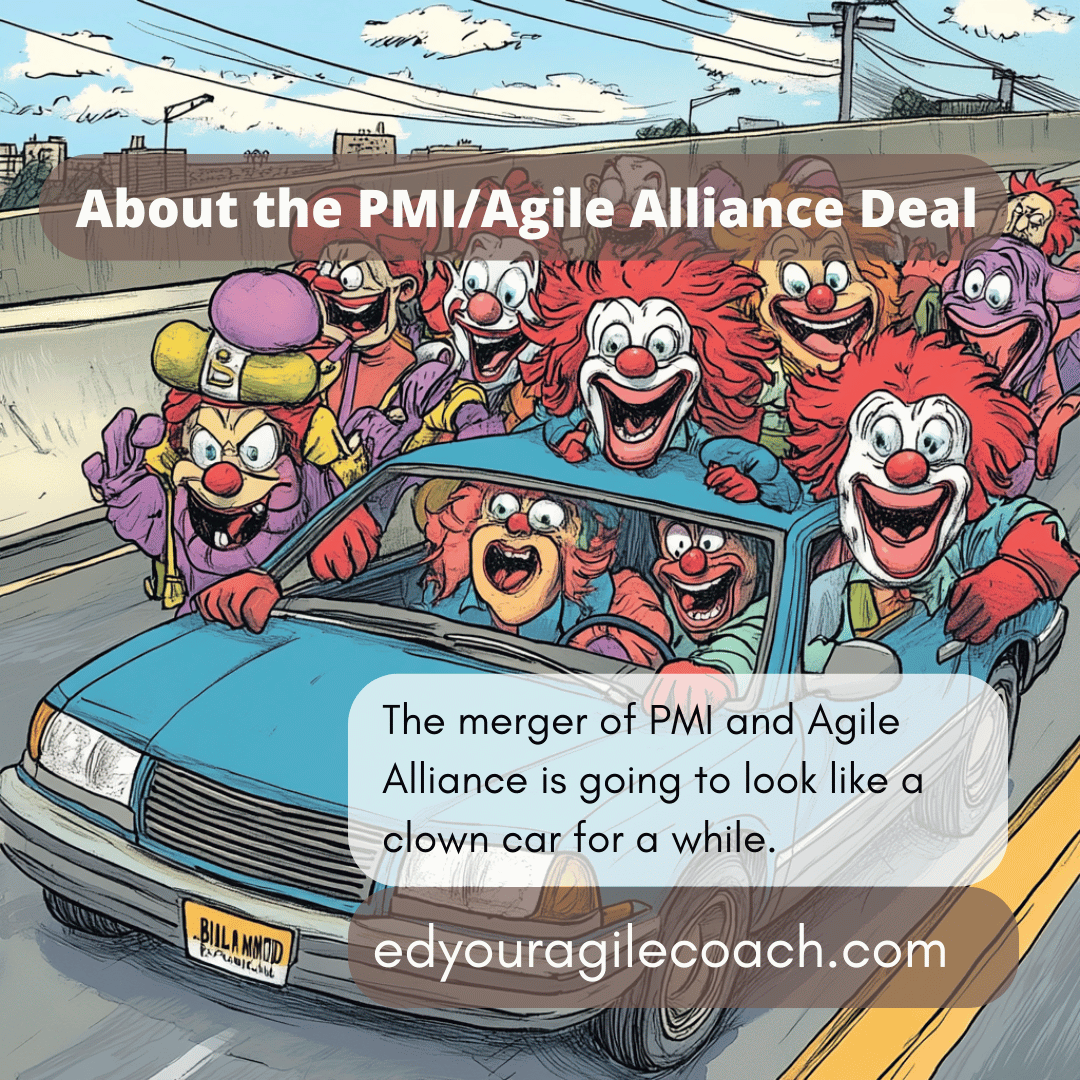If you can't beat them, join them.

The merger of the PMI with the Agile Alliance is big news, and here is my take on the subject.
The New Year is more jam-packed than a commuter bus on a Monday morning. The government will experience a peaceful power transfer from the current administration to one that attempted an insurrection four years ago. Meanwhile, the nation will hold a state funeral for a principled man who served as president forty-five years earlier and earned the Nobel Peace Prize for his work as an ex-president. Finally, with the dust shaking off the regulatory environment, a new batch of mergers and acquisitions is about to begin. The first was the surprise announcement of the merger of the Agile Alliance with the PMI Institute. I have to confess this news was not on my bingo card, but it represents a paradigm shift in the Agile community, and I want to put it into perspective.
The Project Management Institute (PMI) announced the merger on January 3rd. While unexpected, the news followed earlier 2024 foreshadowing. The Agile 2024 conference suffered from poor attendance, prompting the organization to post an online message encouraging members to donate to its support. The internet received the message with grim chortling because many agile professionals were dealing with unemployment and a difficult job market. It appears that the downturn in the agile job market directly impacted the Alliance, and to preserve its influence, it decided to get absorbed by the Project Management Insitute.

The news spread quickly over social media, particularly LinkedIn, and the response was a muted shock and sadness. Thanks to the downturn in the agile market, it felt like a defeat to many of us. The Agile Alliance was not-for-profit and encouraged people from different camps in the agile reformation to collaborate. Many of the manifesto's signatories were involved in the organization, and it has the collegial feel of an organization that hosts academic conferences. It was also a prestigious place to present a white paper and network with others. I have many fond memories of my presentation at the Agile 2018 conference.
The Alliance was our place to declare our independence from traditional project management. The Agile Manifesto was a rejection of the project management techniques we experienced. The top-down command and control approach that dominated twenty-five years ago led to cost overruns and failed projects. Those of us who belonged to the Alliance knew what we stood for and, more importantly, what we stood against, which was the PMI's bureaucratic nature and their process enforcers, the Project Management Professional.
It has the feel of being a buccaneering pirate. We disrupted the business world, made money, and enjoyed adventure. All periods of disruption eventually end. As people began to emerge from the aftermath of COVID-19, business leaders thought they could snap their fingers and people would return to the office. Office workers had different ideas and complicated technology projects at major companies like Meta and Microsoft flounders. Executives unfairly blamed Agile professionals for these failed projects and initiatives. The disruption of agility ran into the cultural inertia of prominent corporations, and inertia won.
Capital One laid off its Agile coaching contingent, and other businesses followed suit. The new word among executives was delivery instead of agility. The people paying the bills wanted work to get done, and if the organization happened to become more agile, it was considered a bonus. It also did not help that Agile practitioners began using out-of-the-box approaches and anti-patterns known as "dark scrum" to try and improve business processes. Consulting dollars dried up, and people lost their jobs. These trends had to impact the trade organizations that supported the movement.
We traded swashbuckling for the humbling search for work. Job posts reflected this shift as organizations yearned to combine Agile's adaptability with the accountability of traditional project management. Organizations expect coaches to have agile credentials and traditional project management skills. During a bout of joblessness, it forced me to earn a PMP. I became what I opposed. It feels like a page has turned in the industry, but the bad guys have not won. Instead, they used agility to improve their approach to projects.
My PMP training leveraged plenty of agile techniques, and the PMP curriculum fully integrates the principles and values of the Agile Manifesto. Suppose traditional project management complements the Agile way of doing work. In that case, it means that the two schools are coming together to synthesize work where we take the strengths of each approach and leverage them. Being a good project manager makes me a better agile person and vice versa. It is a strange situation because the people who often were our worst opponents in organizations were PMPs. Taking iterative approaches to work and hybrid project management is all the rage today. We didn't defeat waterfall project management; its practitioners sought to join our Agile movement. It created an uncomfortable and awkward situation.
Often in our coaching practice, we talk about our discomfort and learning to grow accustomed to change and discomfort. The news of the PMI/Agile Alliance merges is a severe test of this mindset. We must learn to work with project management processes executives are comfortable with and reform systems from the inside. I think this merger will be positive if we approach it with the same agility we used when we launched this movement over twenty years ago. Paradigm shifts happen in science, culture, and politics. It was just a matter of time before it happened in the Agile Reformation. It is time to respond to this change rather than stick with an obsolete plan.
Until next time.




Comments ()